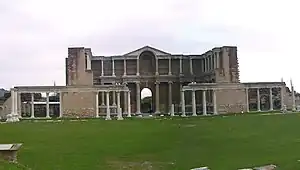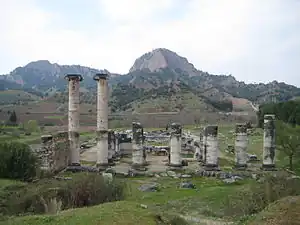Sardis
ancient city at the location of modern Sart
Sart is a small farming village in the Central Aegean Region of Turkey, better known as Sardis the ruined capital of Lydia.
King Croesus ruled here from 585 BC, expanding Lydia to cover the western third of Asian Turkey. One reason for his success and legendary wealth was that the river Pactolus through Sardis had alluvial gold, minted into gold coinage and - crucially - with standards set for purity. That meant you could trust Lydian money in an era when other coins were suspect. Croesus was overthrown by the Persians in 547 BC and probably didn't survive long after. Then Sardis became a major city of the Persian Empire and the western terminus of the Royal Road, the ancient imperial highway linking to the Silk Road.
Sardis eventually became part of the Roman Empire. It was destroyed in an earthquake of 17 AD but rebuilt, and later in that century hosted one of the Seven Churches of Asia addressed in the New Testament Book of Revelation. Its author St John of Patmos variously harangued, exhorted or praised these churches - overall he preferred haranguing and Sardis caught its share. The city lost its importance as Constantinople grew, as it wasn't on any direct route, as modern travellers from Istanbul are destined to discover.


